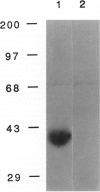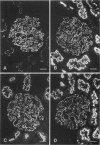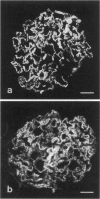Abstract
There is considerable evidence that glomerular deposits in Heymann nephritis, a rat model of membranous nephritis, result from shedding of immune complexes formed on podocytes and that the principal antigen is part of the extracellular domain of a cell surface glycoprotein receptor called gp330 or megalin. It has also been reported that the immunogen that induces Heymann nephritis is a complex formed between gp330 and the receptor-associated protein RAP. The recent elucidation of the primary structure of gp330 makes it possible to investigate the ability of defined portions of gp330, devoid of RAP, to induce Heymann nephritis. In the present study we show that a gp330-glutathione-S-transferase fusion protein, containing 137 amino acid residues (1114 to 1250) of the ectodomain, induces active Heymann nephritis and that heterologous antibodies against this fusion protein produce passive Heymann nephritis. By immunofluorescence, typical glomerular immunoglobulin deposits were found, but complement components were lacking and the rats did not develop proteinuria. In the active model, we obtained evidence indicating that the deposits contained portions of the ectodomain of gp330, including regions other than those of the fusion protein. Thus, the deposits were stained by polyclonal antibodies to gp330 and to the gp330 fusion protein, as well as by two monoclonal antibodies reactive with portions of the ectodomain of gp330, only one of which reacted with the fusion protein in vitro. Antibodies against the cytoplasmic domain of gp330 did not stain. Furthermore, we found that RAP was able to bind to gp330 in the glomerular deposits but not to the gp330 fusion protein in vitro. The results show that the region of gp330 spanning amino acid residues 1114 to 1250 contains peptides capable of inducing pathogenic antibodies of Heymann nephritis without a contributory role of RAP.
Full text
PDF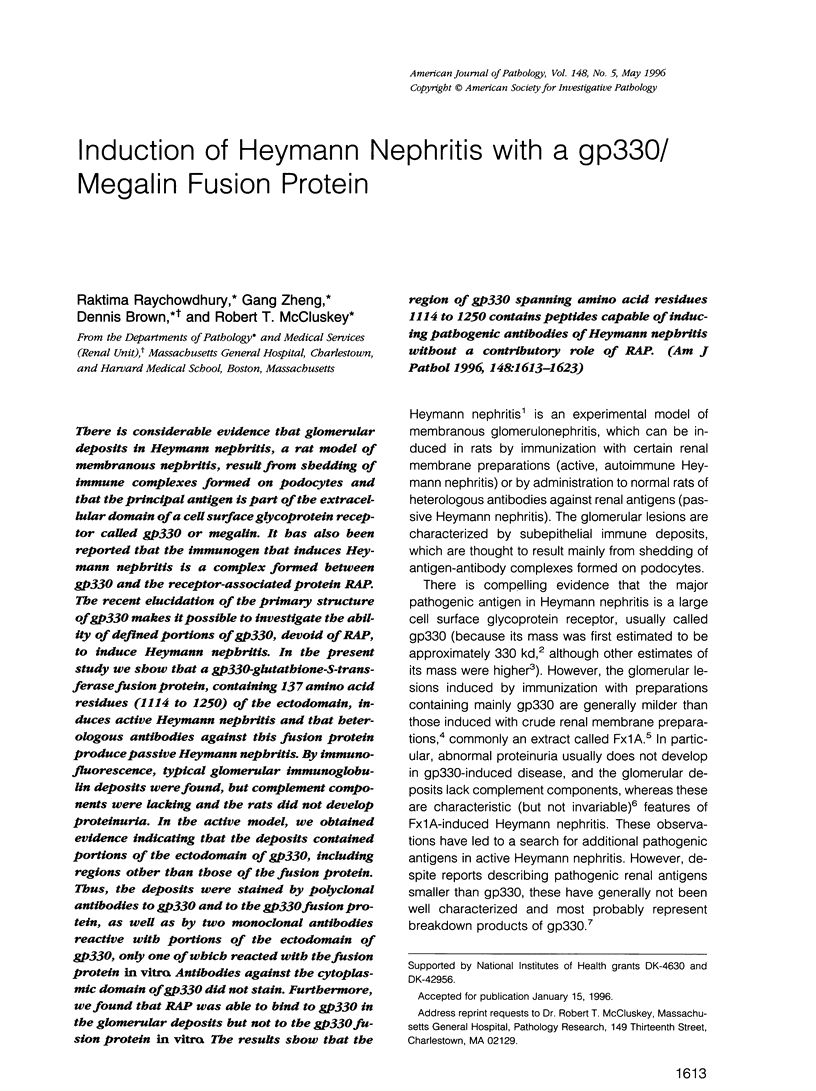

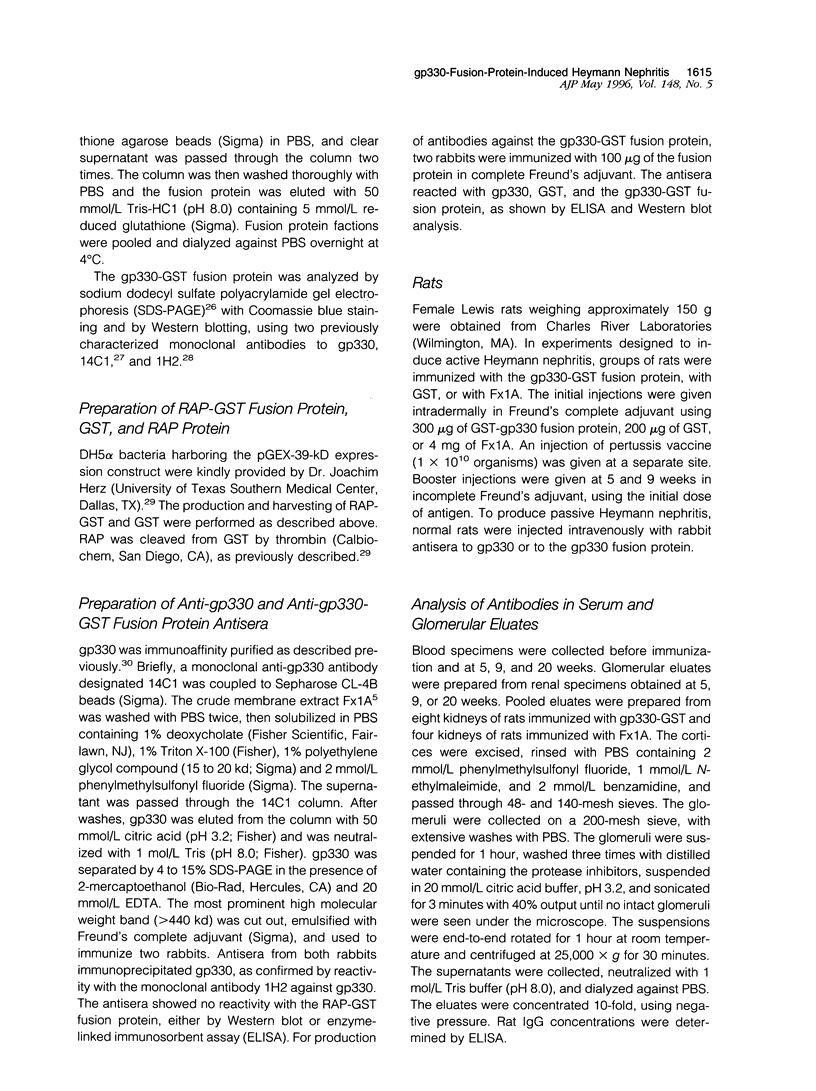



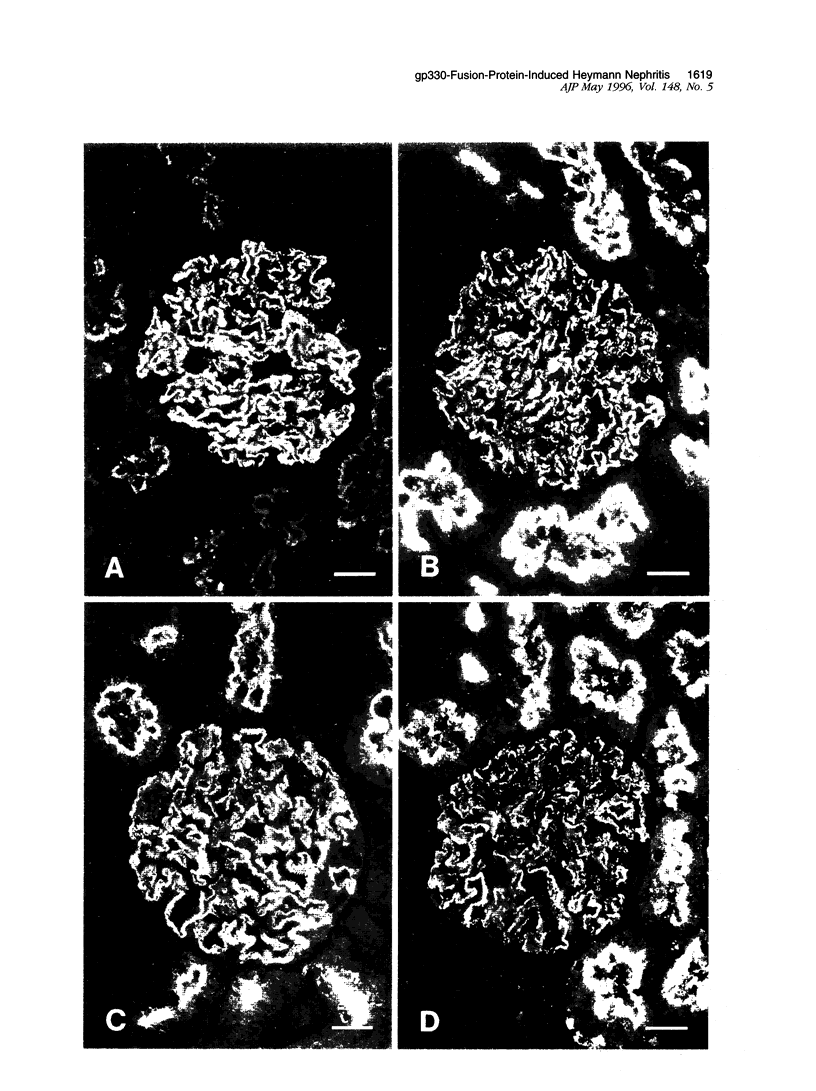

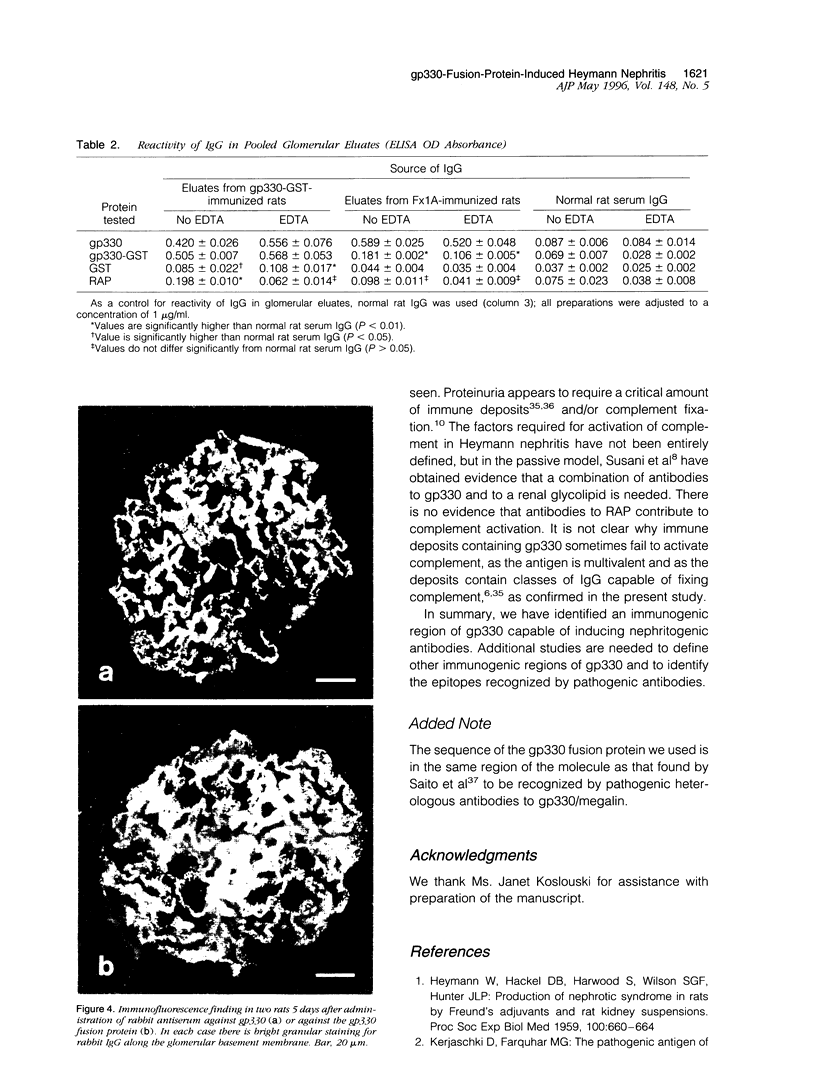
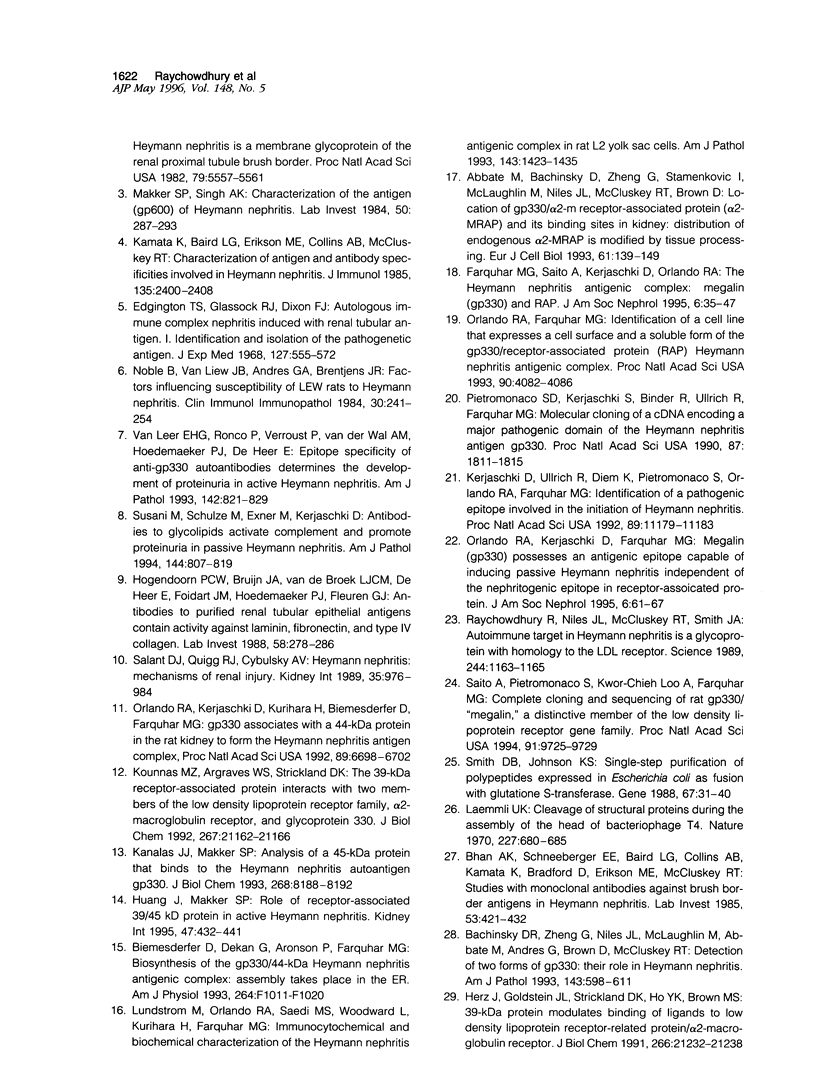
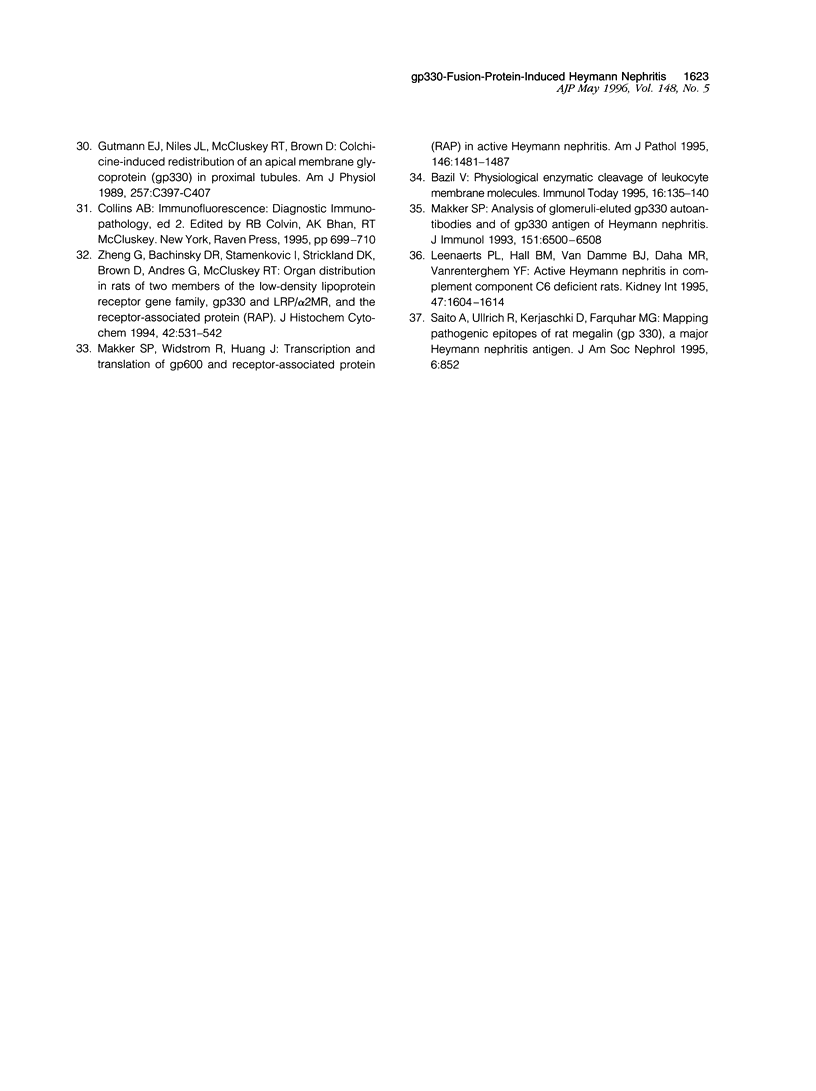
Images in this article
Selected References
These references are in PubMed. This may not be the complete list of references from this article.
- Abbate M., Bachinsky D., Zheng G., Stamenkovic I., McLaughlin M., Niles J. L., McCluskey R. T., Brown D. Location of gp330/alpha 2-m receptor-associated protein (alpha 2-MRAP) and its binding sites in kidney: distribution of endogenous alpha 2-MRAP is modified by tissue processing. Eur J Cell Biol. 1993 Jun;61(1):139–149. [PubMed] [Google Scholar]
- Bachinsky D. R., Zheng G., Niles J. L., McLaughlin M., Abbate M., Andres G., Brown D., McCluskey R. T. Detection of two forms of GP330. Their role in Heymann nephritis. Am J Pathol. 1993 Aug;143(2):598–611. [PMC free article] [PubMed] [Google Scholar]
- Bazil V. Physiological enzymatic cleavage of leukocyte membrane molecules. Immunol Today. 1995 Mar;16(3):135–140. doi: 10.1016/0167-5699(95)80130-8. [DOI] [PubMed] [Google Scholar]
- Bhan A. K., Schneeberger E. E., Baird L. G., Collins A. B., Kamata K., Bradford D., Erikson M. E., McCluskey R. T. Studies with monoclonal antibodies against brush border antigens in Heymann nephritis. Lab Invest. 1985 Oct;53(4):421–432. [PubMed] [Google Scholar]
- Biemesderfer D., Dekan G., Aronson P. S., Farquhar M. G. Biosynthesis of the gp330/44-kDa Heymann nephritis antigenic complex: assembly takes place in the ER. Am J Physiol. 1993 Jun;264(6 Pt 2):F1011–F1020. doi: 10.1152/ajprenal.1993.264.6.F1011. [DOI] [PubMed] [Google Scholar]
- Edgington T. S., Glassock R. J., Dixon F. J. Autologous immune complex nephritis induced with renal tubular antigen. I. Identification and isolation of the pathogenetic antigen. J Exp Med. 1968 Mar 1;127(3):555–572. doi: 10.1084/jem.127.3.555. [DOI] [PMC free article] [PubMed] [Google Scholar]
- Farquhar M. G., Saito A., Kerjaschki D., Orlando R. A. The Heymann nephritis antigenic complex: megalin (gp330) and RAP. J Am Soc Nephrol. 1995 Jul;6(1):35–47. doi: 10.1681/ASN.V6135. [DOI] [PubMed] [Google Scholar]
- Gutmann E. J., Niles J. L., McCluskey R. T., Brown D. Colchicine-induced redistribution of an apical membrane glycoprotein (gp330) in proximal tubules. Am J Physiol. 1989 Aug;257(2 Pt 1):C397–C407. doi: 10.1152/ajpcell.1989.257.2.C397. [DOI] [PubMed] [Google Scholar]
- HEYMANN W., HACKEL D. B., HARWOOD S., WILSON S. G., HUNTER J. L. Production of nephrotic syndrome in rats by Freund's adjuvants and rat kidney suspensions. Proc Soc Exp Biol Med. 1959 Apr;100(4):660–664. doi: 10.3181/00379727-100-24736. [DOI] [PubMed] [Google Scholar]
- Herz J., Goldstein J. L., Strickland D. K., Ho Y. K., Brown M. S. 39-kDa protein modulates binding of ligands to low density lipoprotein receptor-related protein/alpha 2-macroglobulin receptor. J Biol Chem. 1991 Nov 5;266(31):21232–21238. [PubMed] [Google Scholar]
- Hogendoorn P. C., Bruijn J. A., vd Broek L. J., De Heer E., Foidart J. M., Hoedemaeker P. J., Fleuren G. J. Antibodies to purified renal tubular epithelial antigens contain activity against laminin, fibronectin, and type IV collagen. Lab Invest. 1988 Mar;58(3):278–286. [PubMed] [Google Scholar]
- Huang J., Makker S. P. Role of receptor-associated 39/45 kD protein in active Heymann nephritis. Kidney Int. 1995 Feb;47(2):432–441. doi: 10.1038/ki.1995.56. [DOI] [PubMed] [Google Scholar]
- Kamata K., Baird L. G., Erikson M. E., Collins A. B., McCluskey R. T. Characterization of antigens and antibody specificities involved in Heymann nephritis. J Immunol. 1985 Oct;135(4):2400–2408. [PubMed] [Google Scholar]
- Kanalas J. J., Makker S. P. Analysis of a 45-kDa protein that binds to the Heymann nephritis autoantigen GP330. J Biol Chem. 1993 Apr 15;268(11):8188–8192. [PubMed] [Google Scholar]
- Kerjaschki D., Ullrich R., Diem K., Pietromonaco S., Orlando R. A., Farquhar M. G. Identification of a pathogenic epitope involved in initiation of Heymann nephritis. Proc Natl Acad Sci U S A. 1992 Dec 1;89(23):11179–11183. doi: 10.1073/pnas.89.23.11179. [DOI] [PMC free article] [PubMed] [Google Scholar]
- Kounnas M. Z., Argraves W. S., Strickland D. K. The 39-kDa receptor-associated protein interacts with two members of the low density lipoprotein receptor family, alpha 2-macroglobulin receptor and glycoprotein 330. J Biol Chem. 1992 Oct 15;267(29):21162–21166. [PubMed] [Google Scholar]
- Laemmli U. K. Cleavage of structural proteins during the assembly of the head of bacteriophage T4. Nature. 1970 Aug 15;227(5259):680–685. doi: 10.1038/227680a0. [DOI] [PubMed] [Google Scholar]
- Leenaerts P. L., Hall B. M., Van Damme B. J., Daha M. R., Vanrenterghem Y. F. Active Heymann nephritis in complement component C6 deficient rats. Kidney Int. 1995 Jun;47(6):1604–1614. doi: 10.1038/ki.1995.224. [DOI] [PubMed] [Google Scholar]
- Lundstrom M., Orlando R. A., Saedi M. S., Woodward L., Kurihara H., Farquhar M. G. Immunocytochemical and biochemical characterization of the Heymann nephritis antigenic complex in rat L2 yolk sac cells. Am J Pathol. 1993 Nov;143(5):1423–1435. [PMC free article] [PubMed] [Google Scholar]
- Makker S. P. Analysis of glomeruli-eluted Gp330 autoantibodies and of Gp330 antigen of Heymann nephritis. J Immunol. 1993 Dec 1;151(11):6500–6508. [PubMed] [Google Scholar]
- Makker S. P., Singh A. K. Characterization of the antigen (gp600) of Heymann nephritis. Lab Invest. 1984 Mar;50(3):287–293. [PubMed] [Google Scholar]
- Makker S. P., Widstrom R., Huang J. Transcription and translation of gp600 and receptor-associated protein (RAP) in active Heymann nephritis. Am J Pathol. 1995 Jun;146(6):1481–1487. [PMC free article] [PubMed] [Google Scholar]
- Noble B., Van Liew J. B., Andres G. A., Brentjens J. R. Factors influencing susceptibility of LEW rats to Heymann nephritis. Clin Immunol Immunopathol. 1984 Feb;30(2):241–254. doi: 10.1016/0090-1229(84)90059-x. [DOI] [PubMed] [Google Scholar]
- Orlando R. A., Farquhar M. G. Identification of a cell line that expresses a cell surface and a soluble form of the gp330/receptor-associated protein (RAP) Heymann nephritis antigenic complex. Proc Natl Acad Sci U S A. 1993 May 1;90(9):4082–4086. doi: 10.1073/pnas.90.9.4082. [DOI] [PMC free article] [PubMed] [Google Scholar]
- Orlando R. A., Kerjaschki D., Farquhar M. G. Megalin (gp330) possesses an antigenic epitope capable of inducing passive Heymann nephritis independent of the nephritogenic epitope in receptor-associated protein. J Am Soc Nephrol. 1995 Jul;6(1):61–67. doi: 10.1681/ASN.V6161. [DOI] [PubMed] [Google Scholar]
- Orlando R. A., Kerjaschki D., Kurihara H., Biemesderfer D., Farquhar M. G. gp330 associates with a 44-kDa protein in the rat kidney to form the Heymann nephritis antigenic complex. Proc Natl Acad Sci U S A. 1992 Aug 1;89(15):6698–6702. doi: 10.1073/pnas.89.15.6698. [DOI] [PMC free article] [PubMed] [Google Scholar]
- Pietromonaco S., Kerjaschki D., Binder S., Ullrich R., Farquhar M. G. Molecular cloning of a cDNA encoding a major pathogenic domain of the Heymann nephritis antigen gp330. Proc Natl Acad Sci U S A. 1990 Mar;87(5):1811–1815. doi: 10.1073/pnas.87.5.1811. [DOI] [PMC free article] [PubMed] [Google Scholar]
- Raychowdhury R., Niles J. L., McCluskey R. T., Smith J. A. Autoimmune target in Heymann nephritis is a glycoprotein with homology to the LDL receptor. Science. 1989 Jun 9;244(4909):1163–1165. doi: 10.1126/science.2786251. [DOI] [PubMed] [Google Scholar]
- Saito A., Pietromonaco S., Loo A. K., Farquhar M. G. Complete cloning and sequencing of rat gp330/"megalin," a distinctive member of the low density lipoprotein receptor gene family. Proc Natl Acad Sci U S A. 1994 Oct 11;91(21):9725–9729. doi: 10.1073/pnas.91.21.9725. [DOI] [PMC free article] [PubMed] [Google Scholar]
- Salant D. J., Quigg R. J., Cybulsky A. V. Heymann nephritis: mechanisms of renal injury. Kidney Int. 1989 Apr;35(4):976–984. doi: 10.1038/ki.1989.81. [DOI] [PubMed] [Google Scholar]
- Smith D. B., Johnson K. S. Single-step purification of polypeptides expressed in Escherichia coli as fusions with glutathione S-transferase. Gene. 1988 Jul 15;67(1):31–40. doi: 10.1016/0378-1119(88)90005-4. [DOI] [PubMed] [Google Scholar]
- Susani M., Schulze M., Exner M., Kerjaschki D. Antibodies to glycolipids activate complement and promote proteinuria in passive Heymann nephritis. Am J Pathol. 1994 Apr;144(4):807–819. [PMC free article] [PubMed] [Google Scholar]
- Van Leer E. H., Ronco P., Verroust P., van der Wal A. M., Hoedemaeker P. J., De Heer E. Epitope specificity of anti-gp330 autoantibodies determines the development of proteinuria in active Heymann nephritis. Am J Pathol. 1993 Mar;142(3):821–829. [PMC free article] [PubMed] [Google Scholar]
- Zheng G., Bachinsky D. R., Stamenkovic I., Strickland D. K., Brown D., Andres G., McCluskey R. T. Organ distribution in rats of two members of the low-density lipoprotein receptor gene family, gp330 and LRP/alpha 2MR, and the receptor-associated protein (RAP). J Histochem Cytochem. 1994 Apr;42(4):531–542. doi: 10.1177/42.4.7510321. [DOI] [PubMed] [Google Scholar]



